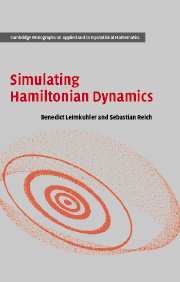Book contents
- Frontmatter
- Contents
- Preface
- Acknowledgements
- 1 Introduction
- 2 Numerical methods
- 3 Hamiltonian mechanics
- 4 Geometric integrators
- 5 The modified equations
- 6 Higher-order methods
- 7 Constrained mechanical systems
- 8 Rigid body dynamics
- 9 Adaptive geometric integrators
- 10 Highly oscillatory problems
- 11 Molecular dynamics
- 12 Hamiltonian PDEs
- References
- Index
8 - Rigid body dynamics
Published online by Cambridge University Press: 04 December 2009
- Frontmatter
- Contents
- Preface
- Acknowledgements
- 1 Introduction
- 2 Numerical methods
- 3 Hamiltonian mechanics
- 4 Geometric integrators
- 5 The modified equations
- 6 Higher-order methods
- 7 Constrained mechanical systems
- 8 Rigid body dynamics
- 9 Adaptive geometric integrators
- 10 Highly oscillatory problems
- 11 Molecular dynamics
- 12 Hamiltonian PDEs
- References
- Index
Summary
In this chapter, we discuss formulation issues and symplectic integration methods for simulating the motion of a rigid body. Rigid bodies arise frequently in engineering, chemistry, and physics. For example, they occur in molecular simulation when the flexibility of small polyatomic units such as the water molecule, or CH4 is ignored. Cogwheels, space vehicles, and the planets are some other objects that are commonly modeled by rigid bodies.
Even in the absence of external applied forces, any rigid body more complicated than a uniform sphere will exhibit complicated motion, as defined by the moments of inertia of the body. A hint of the potential complexity of the motion is provided by the classic illustration using a hardbound book, which typically has three unequal moments of inertia I1 < I2 < I3 with I1 corresponding to an axis drawn along the binding, I2 to an axis across the cover, and I3 to an axis through the pages of the book (see Fig. 8.1). As the book is tossed up and spinning around each of the axes, the following dynamics are observed: around the first and third axes, the motion combines a stable periodic rotation with the rising and falling motion due to gravity, whereas the rotation with respect to the middle axis is much more complicated. (See, for example, for more explanation.) (It helps to place a rubber band around the book's cover to keep it closed while conducting experiments.)
Developing a method to simulate general rigid body motions, especially for long-term integration, proves an interesting and challenging task. The first issue we must confront is the selection of a set of coordinates that describe body orientation and spatial position.
- Type
- Chapter
- Information
- Simulating Hamiltonian Dynamics , pp. 199 - 233Publisher: Cambridge University PressPrint publication year: 2005



